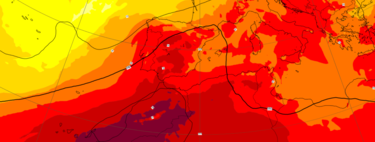Spain is currently the best example of a much deeper problem that comes with infernal heat in much of the planet: how to fight the fuego with the working day (and life in general). Five workers died during the first heat wave, and that is why it is prioritized to adapt the day (or suspend it) when those hours arrive in which Sun does not let us move forward.
And, meanwhile, in India it is 10 in the morning and they already have 40 degrees. How the hell do they do?
Heat as law. The New York Times counted in a report how the fire is fought in the most suffocating city. In Sri Ganganagar, a semi -desert region of the Indian state of Rajastán, everyday life has adapted to temperatures that, in the middle of June, reach 49 ° C. There, where dawn already begins at 30 ° C and by 10 in the morning the thermometer exceeds 40 ° C, heat is not a seasonal phenomenon: it is a structural condition that conditions work, health, rest and human relationships.
The population, mostly agricultural and without access to comforts such as air conditioning, has developed a daily choreography that folds to the abrasing rhythms of the weather and the sun.
Follow the sun. The key? The working hours begin before dawn: peasants and workers take advantage of the few fresh hours to work in the fields and constructions, before taking refuge where they can when the sun becomes unbearable.
The houses are emptied at noon, the markets close, and the few active services, such as street food carts, work under temperatures that melt the asphalt. The scene is repeated every summer with an increasing intensity, aggravated by a rising humidity that multiplies physical suffering.


Atardecer en Sri Ganganagar
The thermal abyss. We go from Sri ganganagar to another “extreme” region. They explained in Bloomberg that in the western city of Ahmedabad, where the thermometers usually exceed 45 ° C at the beginning of May, the fight against heat has also ceased to be a seasonal issue to become a structural need. In this environment, exposure to the sun is no longer just a labor risk: it is a direct threat to health, food security and economic stability of millions of people.
For women like Kunwar Ben Chauhan, who sells meat in the street and has suffered fainting, dehydration and economic losses due to the deterioration of their products, extreme heat imposes impossible dilemmas: going out to work and risk life, or stay at home and lose daily sustenance. Faced with this reality, groups such as Self-Employed Women’s Association (SEWA) display pioneer solutions such as parametric insurance, which grants automatic economic compensation when the temperature exceeds certain critical thresholds. The measure, although modest, represents a vital lifeguard in an informal economy where many workers earn just three dollars daily.


Ahmedabad
Adaptation from below. In Ahmedabad, a metropolis of more than 8.5 million inhabitants, resilience is built from the community fabric. In addition to climate insurance, initiatives such as ceilings coating with reflective paint and the installation of early warning systems are transforming the way in which heat is perceived and managed. The city, a pioneer in Asia del Sur, launched in 2013 its own action for heat after the devastating wave of 2010, in which more than 1,300 people died and up to 400 bats fell dead by the burning air.
Since then, the actions have multiplied: hospitals now have special rooms to treat heat stroke, dehydration and burns, community centers, temples and shopping centers become climatic shelters during the most extreme days, and awareness campaigns have been implemented through radio, neighborhood leaders and educators. The plan includes a colored alert system that informs the population, and whose efficacy has contributed to reduce mortality.
Heat and health. Back to Ganganagar, the other strategies underlined. In the Chak Maharaj Ka clinic, patient flow increases as heat becomes unbearable. Those who suffer from previous diseases such as asthma or gastrointestinal conditions see how their ailments intensify, forcing medical staff to resort to rapid and palliative treatments. Most of the inhabitants have internalized basic survival strategies: avoid going out in critical hours, hydrating with homemade solutions, or resting under trees when there is no other option.
It happens that these methods only partially relieve a problem that threatens every aspect of life. In the epicenter of heat, in the city itself, the activity never stops at all. As in Ahmedabad, workers cannot afford to rest: if they don’t work, they don’t eat.

Solidarity under the sun. Despite the relentless environment, gestures of daily humanity arise that become pillars of a shared ethic. At 3 in the afternoon, when the temperature reaches its maximum point in Ganganagar, whole families go to the road with water cubes to offer relief to motorcyclists, truckers and travelers stunned by heat.
The act, although simple, embodies a deep sense of charity in a society where doing good is seen as the way to spiritual salvation. For many, giving water to a stranger is the only lasting legacy that can be offered in a world where everything else is Evapora Under the sun.
Climate Innovation Laboratory. Behind the pioneer action plan of the city of Ahmedabad there is a growing understanding that heat is not an anecdotal phenomenon, but a dangerous multiplier of vulnerabilities in a country where cities grow disorderly, cement replaces vegetation and global emissions have raised the average temperature of the planet by 1.2 ° C from the pre -industrial era.
Recent studies warn that if global warming exceeds 2 ° C (an increasingly close possibility) India will experience a six -time increase in the frequency of heat waves. Already today, more than 600 million Indians live under an unprecedented thermal threat. In that scenario, the city has become an urban adaptation laboratory, whose innovations (such as the insurance algorithm that contemplates variables such as night temperature, cloudiness and pollution) are being replicated in other cities. Organizations such as Global Parametrics, in alliance with Mahila Housing Trust, are designing scalable schemes to extend this climate protection nationwide.
The culture of heat. They also remembered in Bloomberg that one of Ahmedabad’s most significant achievements has been to transform heat perception. In a culture where high temperatures were seen as part of the natural landscape, getting citizens (from workers to health officials) to recognize heat as a legitimate threat has been a deep cultural change.
In that regard, popular education, neighborhood training and strategies in mouths have been essential. Women, traditionally more exposed for their domestic works and roles, have been the first to absorb and disseminate knowledge about ventilation, hydration and thermal hazards. Thus, thanks to this sustained effort, the language of climate risk is already part of the daily vocabulary of Ahmedabad.

Dusk without relief. But even that culture meets an increasingly complicated reality in places as extremes as Sri ganganagar. There, after the afternoon, the town begins to relive. The markets reopen, the elders sit in a circle to talk and the children return to the channel where they bathed earlier. It happens that with sunset, the air remains hot and sticky. He explained the times cases of families, such as Gurmail Singh, who prepare their beds in outdoor courtyards, trying to capture some breeze that mitigates embarrassment.
Because the night does not offer real comfort: the dream becomes elusive and the rest, a luxury. In India that warms up to double the world rhythm, Sri ganganagar or Ahmedabad not only resist: redefine the meaning of human adaptation, an adaptation that will sooner or later reach us all according to science.
Imagen | Hippox, Stalinjeet Brar, sandeepacheta, PXHere
In WorldOfSoftware | We have good news about the extreme heat of this summer. It will be carried compared to the one in the coming years
In WorldOfSoftware | The hope against the increasingly extreme heat waves comes from China: a material that lowers the temperature automatically












